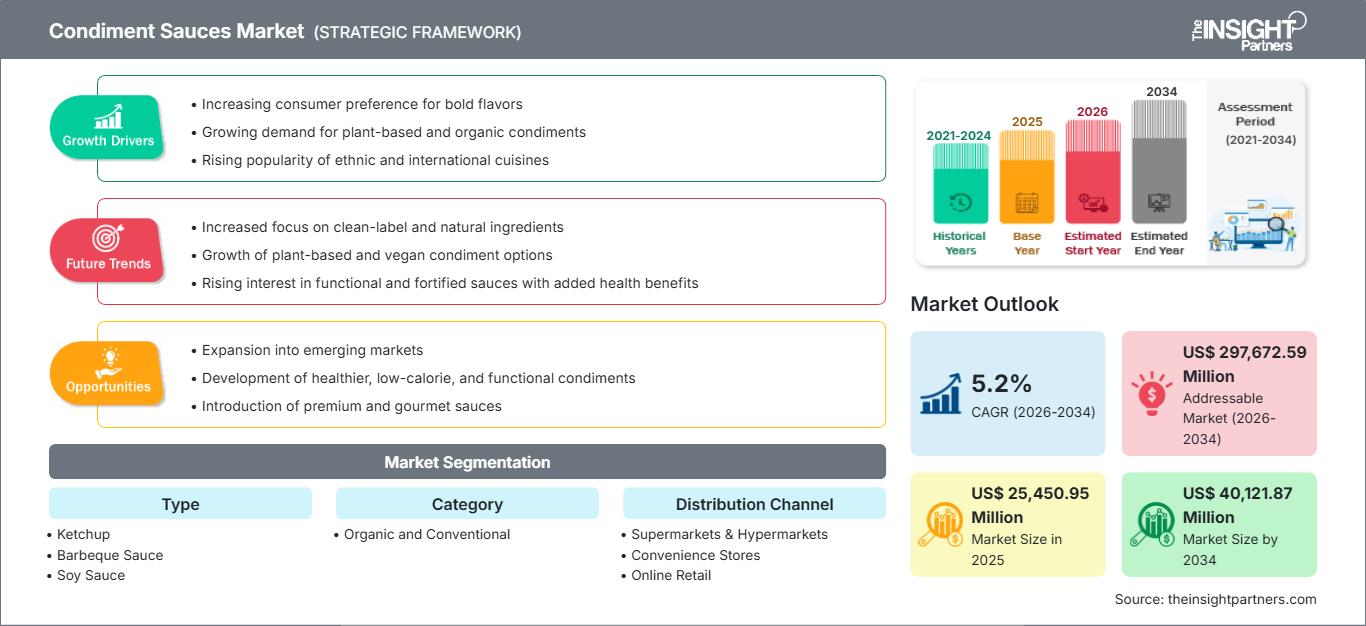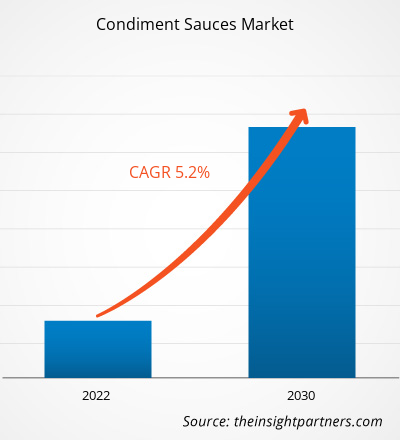Il mercato delle salse condite, valutato a 25.450,95 milioni di dollari nel 2025, dovrebbe raggiungere i 40.121,87 milioni di dollari entro il 2034, con un CAGR del 5,2% nel periodo 2026-2034. Le condizioni di mercato continuano a evolversi, aprendo nuove opportunità per gli stakeholder. Il panorama generale riflette un progresso stabile e un potenziale di crescita a lungo termine.
Fattori di crescita e sfide:
I consumatori di tutto il mondo apprezzano sempre di più i sapori variegati dei piatti internazionali, che spaziano dalla cucina asiatica, mediorientale e latinoamericana a quella africana. Inoltre, l'ascesa del turismo gastronomico e la popolarità dei programmi di cucina contribuiscono al desiderio dei consumatori di replicare sapori diversi e sofisticati a casa. Si prevede che questo fattore porterà nuove tendenze nel mercato delle salse condite. Inoltre, food blogger, influencer e community online condividono ricette, tecniche di cottura e consigli per salse condite uniche sui social media e sulle piattaforme digitali. Questo spazio virtuale interconnesso consente loro di scoprire ed esplorare numerose opzioni di salse condite, promuovendo una cultura della sperimentazione e stimolando la domanda di sapori nuovi ed entusiasmanti. Questi fattori svolgono un ruolo importante nel determinare le previsioni del mercato delle salse condite.
I consumatori apprezzano sempre di più sapori diversi e globali. Questa curiosità e apertura a sperimentare nuove cucine crea una domanda di salse e condimenti pratiche e autentiche, in grado di esaltare e personalizzare il gusto di vari piatti e di migliorare l'esperienza culinaria complessiva. I produttori introducono anche varianti esotiche di condimenti, come salse speciali uniche ispirate a diverse tradizioni culinarie. Inoltre, alcuni produttori propongono salse e condimenti artigianali, gourmet e prodotte in piccole quantità, realizzate con ingredienti naturali e di prima qualità, offrendo ai consumatori opzioni di alta qualità che soddisfano i loro palati più esigenti. Questi fattori guidano la crescita del mercato delle salse e condimenti.
L'aumento dei costi associati alla ricerca di fornitori alternativi, alla spedizione rapida o alla gestione di sfide impreviste nella catena di fornitura determina fluttuazioni nei prezzi dei prodotti. Queste fluttuazioni possono rappresentare una sfida per produttori e consumatori, influenzando potenzialmente le decisioni di acquisto e le dinamiche generali del mercato.
Personalizza questo report in base alle tue esigenze
Riceverai la personalizzazione gratuita di qualsiasi report, incluse parti di questo report, analisi a livello nazionale, pacchetto dati Excel e potrai usufruire di fantastiche offerte e sconti per start-up e università.
Mercato delle salse condite: approfondimenti strategici

-
Scopri le principali tendenze di mercato di questo rapporto.Questo campione GRATUITO includerà analisi dei dati, che spaziano dalle tendenze di mercato alle stime e alle previsioni.
Segmentazione e ambito del report:
L'analisi del mercato delle salse condite è stata condotta considerando i seguenti segmenti: tipologia, categoria, canale di distribuzione e area geografica. Il mercato, per tipologia, è segmentato in ketchup, salsa barbecue, salsa di soia, salsa alla senape, salsa chili e altri. In base alla categoria, il mercato è suddiviso in biologico e convenzionale. In base al canale di distribuzione, il mercato è segmentato in supermercati e ipermercati, minimarket, vendita al dettaglio online e altri. Il mercato delle salse condite, per area geografica, è segmentato in Nord America (Stati Uniti, Canada e Messico), Europa (Germania, Francia, Italia, Regno Unito, Russia e resto d'Europa), Asia-Pacifico (Australia, Cina, Giappone, India, Corea del Sud e resto dell'Asia-Pacifico), Medio Oriente e Africa (Sudafrica, Arabia Saudita, Emirati Arabi Uniti e resto del Medio Oriente e Africa) e Sud e Centro America (Brasile, Argentina e resto del Sud e Centro America).
Analisi segmentale:
In base alla categoria, il mercato delle salse per condimenti si divide in biologico e convenzionale. Il segmento convenzionale detiene una quota significativa del mercato globale delle salse per condimenti. Tuttavia, si prevede che il mercato del segmento biologico crescerà significativamente durante il periodo di previsione. I consumatori stanno diventando più attenti alla salute e modificando le loro scelte alimentari, dando priorità a prodotti in linea con i valori di salute e sostenibilità. Le salse per condimenti biologiche, prodotte senza pesticidi sintetici, erbicidi o organismi geneticamente modificati (OGM), sono percepite come opzioni più salutari. Questi prodotti attraggono i consumatori che desiderano ridurre la loro esposizione ad additivi e sostanze chimiche potenzialmente dannosi comunemente presenti nei condimenti convenzionali. Questi fattori stimolerebbero la crescita del mercato del segmento biologico durante il periodo di previsione.
Analisi regionale:
In base all'area geografica, l'ambito del rapporto sul mercato delle salse per condimenti è suddiviso principalmente in cinque regioni: Nord America, Europa, Asia-Pacifico, Sud e Centro America e Medio Oriente e Africa. Il Nord America ha dominato la quota di mercato globale delle salse per condimenti nel 2022. Il mercato nella regione è stato valutato a 7.301,35 milioni di dollari nel 2022. Tuttavia, si prevede che il mercato nell'area Asia-Pacifico registrerà un CAGR del 6,2% durante il periodo di previsione. La crescente popolarità dei ristoranti fast-food, noti anche come ristoranti a servizio rapido (QSR), traina in modo significativo la crescita del mercato nell'area Asia-Pacifico.
Cina, Giappone e India sono i maggiori consumatori di salse per condimenti, grazie alla presenza di un'ampia base di popolazione e all'aumento del numero di ristoranti QSR come Burger King, McDonald's, Wendy's, Subway e Dunkin' Donuts. Questi punti vendita si affidano all'uso di salse per condimenti, puree, marinate e altro ancora per esaltare il gusto e l'aspetto dei prodotti alimentari serviti, contribuendo alla crescita del mercato delle salse per condimenti nella regione. Pertanto, con la crescita del mercato, i produttori globali stanno investendo in modo significativo nella regione per sviluppare il proprio business. Nel giugno 2022, Del Monte ha lanciato Mustard Sauce in India per generare profitti e mantenere la propria posizione competitiva nella regione. Tali iniziative strategiche da parte dei produttori aumentano ulteriormente la quota di mercato delle salse per condimenti nella regione Asia-Pacifico.
Salse Condimento
Approfondimenti regionali sul mercato delle salse condite
Le tendenze regionali e i fattori che influenzano il mercato delle salse per condimenti durante il periodo di previsione sono stati ampiamente spiegati dagli analisti di The Insight Partners. Questa sezione analizza anche i segmenti e la distribuzione geografica del mercato delle salse per condimenti in Nord America, Europa, Asia-Pacifico, Medio Oriente e Africa, Sud e Centro America.
Ambito del rapporto di mercato sulle salse condite
| Attributo del report | Dettagli |
|---|---|
| Dimensioni del mercato nel 2025 | 25.450,95 milioni di dollari USA |
| Dimensioni del mercato entro il 2034 | 40.121,87 milioni di dollari USA |
| CAGR globale (2026 - 2034) | 5,2% |
| Dati storici | 2021-2024 |
| Periodo di previsione | 2026-2034 |
| Segmenti coperti |
Per tipo
|
| Regioni e paesi coperti |
America del Nord
|
| Leader di mercato e profili aziendali chiave |
|
Densità degli attori del mercato delle salse condite: comprendere il suo impatto sulle dinamiche aziendali
Il mercato delle salse condite è in rapida crescita, trainato dalla crescente domanda da parte dei consumatori finali, dovuta a fattori quali l'evoluzione delle preferenze dei consumatori, i progressi tecnologici e una maggiore consapevolezza dei benefici del prodotto. Con l'aumento della domanda, le aziende stanno ampliando la propria offerta, innovando per soddisfare le esigenze dei consumatori e sfruttando le tendenze emergenti, alimentando ulteriormente la crescita del mercato.

- Ottieni una panoramica dei principali attori del mercato delle salse condite
Sviluppi del settore e opportunità future:
Di seguito sono elencate le iniziative intraprese dai principali attori che operano nel mercato globale delle salse condite:
- Nel 2023, Primal Kitchen, un marchio di condimenti, ha aggiunto cinque nuovi prodotti innovativi alla sua gamma di prodotti essenziali per la dispensa. Tra i nuovi prodotti figurano la salsa barbecue coreana biologica, il teriyaki al miele biologico, il Buffalo dolce e delicato, il ketchup biologico "A Tad Sweet" e il condimento e crema spalmabile Whip Dressing & Spread.
- Nel maggio 2022, Veeba, un'azienda indiana produttrice di salse, ha lanciato diversi prodotti, tra cui la salsa Prime Hot Wing, la bustina di ketchup Prime e la bustina di salsa chili.
- Nel giugno 2022, McCormick & Company ha lanciato una versione in edizione limitata di "Old Bay Hot Sauce".
Panorama competitivo e aziende chiave:
Nestlé SA, Develey Senf & Feinkost GmbH, Del Monte International GmbH, McCormick & Co Inc, Melinda's Foods LLC, Kikkoman Corp, Kraft Heinz Co, Ken's Foods Inc, TW Garner Food Co e The Smokey Carter sono tra i principali attori del mercato globale delle salse per condimenti. Questi attori del mercato adottano iniziative di sviluppo strategico per espandere la propria presenza commerciale in tutto il mondo, stimolando ulteriormente la crescita del mercato delle salse per condimenti.
- Analisi storica (2 anni), anno base, previsione (7 anni) con CAGR
- Analisi PEST e SWOT
- Valore/volume delle dimensioni del mercato - Globale, Regionale, Nazionale
- Industria e panorama competitivo
- Set di dati Excel
Report recenti
Testimonianze
Motivo dell'acquisto
- Processo decisionale informato
- Comprensione delle dinamiche di mercato
- Analisi competitiva
- Analisi dei clienti
- Previsioni di mercato
- Mitigazione del rischio
- Pianificazione strategica
- Giustificazione degli investimenti
- Identificazione dei mercati emergenti
- Miglioramento delle strategie di marketing
- Aumento dell'efficienza operativa
- Allineamento alle tendenze normative






















 Ottieni un campione gratuito per - Mercato delle salse condite
Ottieni un campione gratuito per - Mercato delle salse condite